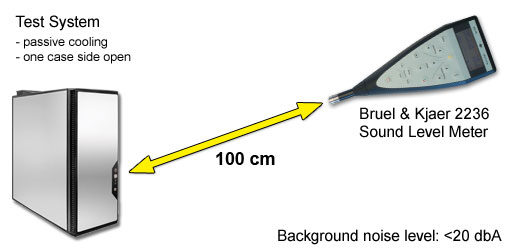 16
16
AMD Radeon R7 260X 2 GB Review
Performance Summary »Fan Noise
In past years, gamers would accept everything for a little bit more performance. Nowadays, users are more aware of the fan noise and the power consumption of their graphics cards.We use the Bruel & Kjaer 2236 sound-level meter (~$4,000) to properly test the fan noise a card emits. It has the measurement range and the accuracy we are looking for.

The tested graphics card was installed in a system that was completely cooled system passively. That is, passive PSU, passive CPU cooler, and passive cooling on the motherboard and a solid state drive. Noise results of other cards on this page are measurements of the respective reference design.
This setup allows us to eliminate secondary noise sources and test only the video card. To be more compliant with standards like DIN 45635 (we are not claiming to be fully DIN 45635 certified), the measurement was conducted at a distance of 100 cm and 160 cm off the floor. Ambient background noise in the room was well below 20 dBA for all measurements. Please note that the dBA scale is not linear but logarithmic. 40 dBA is not twice as loud as 20 dBA, as a 3 dBA increase results in double the sound pressure. The human hearing perception is a bit different, and it is generally accepted that a 10 dBA increase doubles the perceived sound level. 3D load noise levels were tested with a stressful game, not with Furmark.
Idle noise levels are good as the card is barely audible, but the card is way too noisy while gaming, at least for its performance class. It emits noise similar to the much faster GTX Titan. A slightly better heatsink would have definitely helped. Board partners will certainly release custom boards with their own heatsinks to solve this issue.


Feb 26th, 2025 13:01 EST
change timezone
Latest GPU Drivers
New Forum Posts
- The TPU UK Clubhouse (25798)
- Windows 11 General Discussion (5708)
- Post your Steam Game Library Categories (6)
- Post your 7-Zip v22.01 scores (411)
- What local LLM-s you use? (72)
- Are the two M.2 pcie Gen4 x4 slots on my Zen 4 8845HS Socket FP8 Mini-PC equal? (6)
- Intel i7-7700hq undervolt for ntb (3)
- Advice needed for buying a new PSU (17)
- TPU's GPU Database Portal & Updates (388)
- AM3 build, uses in 2025 (2)
Popular Reviews
- Corsair Xeneon 34WQHD240-C Review - Pretty In White
- ASUS GeForce RTX 5070 Ti TUF OC Review
- Corsair Virtuoso MAX Wireless Review
- MSI GeForce RTX 5070 Ti Ventus 3X OC Review
- MSI GeForce RTX 5070 Ti Vanguard SOC Review
- MSI GeForce RTX 5070 Ti Gaming Trio OC+ Review
- darkFlash DY470 Review
- Gigabyte X870 Aorus Elite WiFi 7 Review
- AMD Ryzen 7 9800X3D Review - The Best Gaming Processor
- Gigabyte GeForce RTX 5090 Gaming OC Review
Controversial News Posts
- NVIDIA GeForce RTX 50 Cards Spotted with Missing ROPs, NVIDIA Confirms the Issue, Multiple Vendors Affected (495)
- AMD Radeon 9070 XT Rumored to Outpace RTX 5070 Ti by Almost 15% (304)
- AMD Plans Aggressive Price Competition with Radeon RX 9000 Series (274)
- AMD Radeon RX 9070 and 9070 XT Listed On Amazon - One Buyer Snags a Unit (247)
- NVIDIA Investigates GeForce RTX 50 Series "Blackwell" Black Screen and BSOD Issues (244)
- Edward Snowden Lashes Out at NVIDIA Over GeForce RTX 50 Pricing And Value (241)
- AMD Denies Radeon RX 9070 XT $899 USD Starting Price Point Rumors (239)
- AMD Radeon RX 9070 and 9070 XT Official Performance Metrics Leaked, +42% 4K Performance Over Radeon RX 7900 GRE (186)
